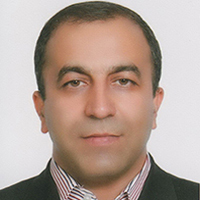Maximum Length of Solute Diffusion in a Parabolic Channel under Permeable and Impermeable Bed Conditions
Author(s):
Abstract:
Introduction
It is important to understand the processes of diffusion and transporting solute in the furrow irrigation system, because of their role in diffusion of pollutants in the environment. Movement pattern of fertilizer from the source ofplants is usually under the effect of advection and turbulent diffusion processes. Maximum solute diffusion length (SDL) is the minimum distance which materials such as a fertilizer, could uniformly spread in the whole flow cross section. The SDL depends on hydraulic properties, condition of vegetation and channel specifications. Velocity profile of furrows as a result of parabolic shape of the cross-section is different thanthe rivers and rectangular channels. The main objectives of this study were to investigate SDL in a permeable parabolic channel and evaluate the effect of different discharges and bed roughness on diffusion length in a parabolic cross-section of a furrow.Materials And Methods
In this research, the effect of different levels of discharge and the bed roughness coefficient was studied on transverse diffusion coefficient (TDC) and the maximum solute diffusion length (SDL) in a parabolic channel with permeable and impermeable beds. The channel had a 10 m length, 0.5 m width and 0.3 m depth with a parabolic shape (similar tothefurrow irrigation system). Before entering the channel, the water flow passed the lattice filters to slow the flow. To increase the rate of flow development, the first half meter of the channels bed covered with gravels (maximum 5 cm thickness) and non-submerged woods. Three levels of discharge about were conducted including 5, 10 and 15 L/s as well as three levels of bed roughness coefficient including 0.2, 0.04 and 0.06. Different rates of roughness were created using various thickness of net and vegetation cover on the furrows bed and wall. This research was conducted in channels with beds of permeable and impermeable. In bed of with permeability, 15 holes with a diameter of 1.5 mm construct along the bed of channel. In this experiment, Sodium chloride as a tracer was injected to the water at the upstream cross section. The place of injection was 2.5 meters far from the channel inlet where flow was completely developed and water surface swings were constant. The tracer concentration in the water and the velocity profile were measured at eight cross sections along the channel including 3, 4, 5, 6, 7, 8, 9 and 9.5 m from upstream. The velocity profile was measured using Pitot tube. No specific equation is introduced to calculate the SDL. For this reason, dimensional analysis was used in this study.Results And Discussion
The results show that, the values of TDC for different treatments ranged between 0.23 to 0.56 cm2/s in impermeable channel where it is 0.30 to 0.58 cm2/s in the permeable channel. Also the values of SDL ranged 108-170 m in impermeable channel and 91 -129 m in the permeable channel for different treatments. TDC has direct relation todischarge and bed roughness. In stationary bed roughness with increased discharge, and in stationary discharge with increasing bed roughness, TDC increased. Also In stationary bed roughness, discharge has positive and direct relation with SDL. However, in stationary discharge, roughness value has the negative relation with SDL. A statistical analysis of T-test indicated that the difference between the values of TDC and SDL in permeable and impermeable beds in the 1% level is significant. The Darcy Weisbach coefficient is the most important parameter in justifyingchanges SDL that this parameter depends on the velocity of flow, and the velocity of flow depends on discharge and shape of channel too. According to the results of the experiments and the regular values of discharge, infiltration and roughness coefficient in furrows, it was shown that the maximum solute diffusion length of furrows would be less than 70 meters.Conclusions
The objective of this research was to develop an approach for the determination of solute diffusion in afurrow irrigation system where the cross section is parabolic. For this reason, solute diffusion length, in different bed roughness and inflow rate was studied. Eventually, an equation was developed to explain SDL in a permeable parabolic channel andthese experimental results could prove useful to predict the fertilizer transport in furrow irrigation method as well as other areas where mixing and contaminant decay is of interest.Language:
Persian
Published:
Journal of water and soil, Volume:31 Issue: 2, 2017
Pages:
399 to 410
magiran.com/p1724923
دانلود و مطالعه متن این مقاله با یکی از روشهای زیر امکان پذیر است:
اشتراک شخصی
با عضویت و پرداخت آنلاین حق اشتراک یکساله به مبلغ 1,390,000ريال میتوانید 70 عنوان مطلب دانلود کنید!
اشتراک سازمانی
به کتابخانه دانشگاه یا محل کار خود پیشنهاد کنید تا اشتراک سازمانی این پایگاه را برای دسترسی نامحدود همه کاربران به متن مطالب تهیه نمایند!
توجه!
- حق عضویت دریافتی صرف حمایت از نشریات عضو و نگهداری، تکمیل و توسعه مگیران میشود.
- پرداخت حق اشتراک و دانلود مقالات اجازه بازنشر آن در سایر رسانههای چاپی و دیجیتال را به کاربر نمیدهد.
In order to view content subscription is required
Personal subscription
Subscribe magiran.com for 70 € euros via PayPal and download 70 articles during a year.
Organization subscription
Please contact us to subscribe your university or library for unlimited access!



